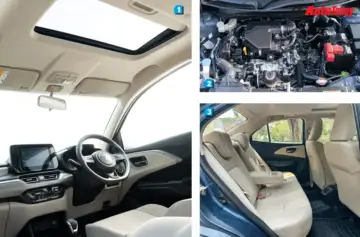After six months with the Maruti Suzuki Dzire, it’s time to say goodbye to a car that quietly but confidently earned its stripes in our long-term fleet. In a lineup packed with more expensive offerings that look the part, the Dzire stood out for its simplicity, reliability, and everyday usability. It was never the loudest or flashiest in the parking lot, but there was a quiet way about its confidence.
 1. The beige is prone to getting dirty, but it adds to the overall sense of space. The cabin felt roomy, and a calm came over me every time I got in to get back home. 2. Not everyone appreciated the three-cylinder shift, to them I say, go and have the pudding! 3. Cushioning was on the softer side, and I liked it that way. Although I never sat in the backseat as often, I did take a few cabs of the latest Tour S, and it felt like a warm hug after a long dayThe main highlight over its tenure has undoubtedly been its 1.2-litre, three-cylinder K12C petrol engine. Smooth, responsive and refined, the motor made city commutes effortless and weaving through traffic joyous. The Dzire’s lightweight build and superbly well-balanced chassis translated to excellent drivability, handling and ride quality. Fuel efficiency consistently hovered around the 16kmpl mark, which only added to its credentials as an ideal daily runner. Inside, comfort was another strong suit. The suspension tuned for everyday Indian roads soaked up most imperfections, and the cabin offered more space than you’d expect from a compact sedan. Its lively chassis setup, sharp steering and all-around good car image grew on me with each passing day.
1. The beige is prone to getting dirty, but it adds to the overall sense of space. The cabin felt roomy, and a calm came over me every time I got in to get back home. 2. Not everyone appreciated the three-cylinder shift, to them I say, go and have the pudding! 3. Cushioning was on the softer side, and I liked it that way. Although I never sat in the backseat as often, I did take a few cabs of the latest Tour S, and it felt like a warm hug after a long dayThe main highlight over its tenure has undoubtedly been its 1.2-litre, three-cylinder K12C petrol engine. Smooth, responsive and refined, the motor made city commutes effortless and weaving through traffic joyous. The Dzire’s lightweight build and superbly well-balanced chassis translated to excellent drivability, handling and ride quality. Fuel efficiency consistently hovered around the 16kmpl mark, which only added to its credentials as an ideal daily runner. Inside, comfort was another strong suit. The suspension tuned for everyday Indian roads soaked up most imperfections, and the cabin offered more space than you’d expect from a compact sedan. Its lively chassis setup, sharp steering and all-around good car image grew on me with each passing day.
 I had my fair share of issues with the AMT, but in the end, I made my peace with it. One thing I feel would’ve made this car perfect is an armrest. It would have made a huge differenceWhat’s more, the 378-litre boot also felt plentiful for airport runs or weekend getaways. But not everything was perfect. The five-speed AMT gearbox felt adequate for calm city driving, but revealed its rough edges in traffic and during overtakes. Shifts were often hesitant and lacked the smoothness we’ve come to expect from modern automatics. And for a top-spec ZXi+ variant, the omission of a front centre armrest felt like an odd oversight. On longer journeys, a little extra bit of elbow support would’ve gone a long way. Nonetheless, I miss shifting that gearbox into manual mode and feeling a greater sense of control. Despite these minor shortcomings, the Dzire remained impressively dependable. It never missed a beat, never threw a tantrum, and never once gave us a reason to doubt its place in the fleet. It may not have the bells and whistles, and its image is that of a cab that’s average and lost amongst the crowd, but what it does have is a strong sense of purpose, and it sticks to it well. As we part ways with this humble yet capable sedan, there’s a genuine sense of appreciation and melancholy. The Dzire did its job without drama, without fuss. And in today’s world of overcomplicated cars, that’s something to be celebrated. I will miss my little blue Dzire immensely.
I had my fair share of issues with the AMT, but in the end, I made my peace with it. One thing I feel would’ve made this car perfect is an armrest. It would have made a huge differenceWhat’s more, the 378-litre boot also felt plentiful for airport runs or weekend getaways. But not everything was perfect. The five-speed AMT gearbox felt adequate for calm city driving, but revealed its rough edges in traffic and during overtakes. Shifts were often hesitant and lacked the smoothness we’ve come to expect from modern automatics. And for a top-spec ZXi+ variant, the omission of a front centre armrest felt like an odd oversight. On longer journeys, a little extra bit of elbow support would’ve gone a long way. Nonetheless, I miss shifting that gearbox into manual mode and feeling a greater sense of control. Despite these minor shortcomings, the Dzire remained impressively dependable. It never missed a beat, never threw a tantrum, and never once gave us a reason to doubt its place in the fleet. It may not have the bells and whistles, and its image is that of a cab that’s average and lost amongst the crowd, but what it does have is a strong sense of purpose, and it sticks to it well. As we part ways with this humble yet capable sedan, there’s a genuine sense of appreciation and melancholy. The Dzire did its job without drama, without fuss. And in today’s world of overcomplicated cars, that’s something to be celebrated. I will miss my little blue Dzire immensely.
